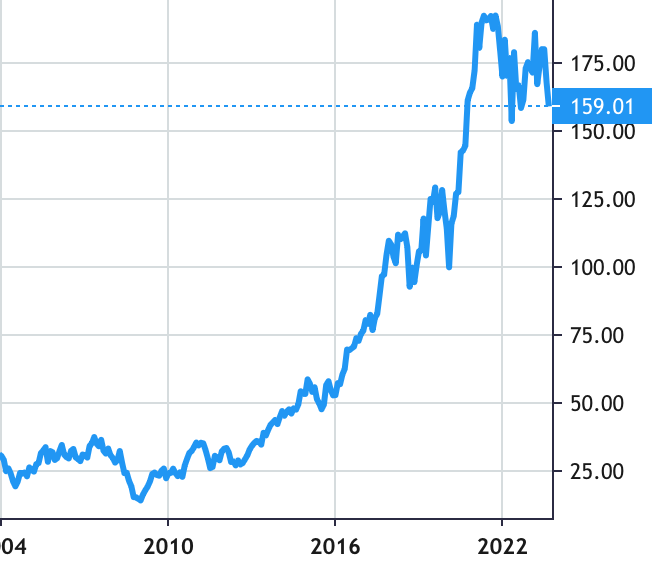About Texas Instruments
Texas Instruments Incorporated designs and manufactures semiconductors that it sells to electronics designers and manufacturers all over the world. The company has design, manufacturing, or sales operations in more than 30 countries.

The company has a diverse product portfolio that is used to accomplish many different things, such as converting and amplifying signals, interfacing with other devices, managing and distributing power, processing data, canceling noise and improving signal resolution. This broad portfolio includes approximately 80,000 products that are integral to almost every type of electronic equipment.
Segments
The company operates through two segments, Analog and Embedded Processing.
Analog segment
Analog semiconductors change real-world signals, such as sound, temperature, pressure or images, by conditioning them, amplifying them and often converting them to a stream of digital data that can be processed by other semiconductors, such as embedded processors. Analog semiconductors are also used to manage power in all electronic equipment by converting, distributing, storing, discharging, isolating and measuring electrical energy, whether the equipment is plugged into a wall or using a battery. As the digitization of electronics continues, there is a growing need and opportunity for analog chips to provide the power to run devices and the critical interfaces with human beings, the real world and other electronic devices. The company’s Analog products are used in many markets, particularly industrial, automotive and personal electronics.

The company’s Analog segment includes the following major product lines: Power and Signal Chain.
Power
Power includes products that help customers manage power in electronic systems. The company’s broad portfolio is designed to manage power requirements across different voltage levels, including battery-management solutions, DC/DC switching regulators, AC/DC and isolated DC/DC switching regulators, power switches, linear and low-dropout regulators, voltage references, and lighting products.
Signal Chain
Signal Chain includes products that sense, condition and measure real-world signals to allow information to be transferred or converted for further processing and control. The company’s Signal Chain products include amplifiers, data converters, interface products, motor drives, clocks, logic and sensing products.
Embedded Processing segment
Embedded Processing products are the digital ‘brains’ of many types of electronic equipment. They are designed to handle specific tasks and can be optimized for various combinations of performance, power and cost, depending on the application. The company’s devices vary from simple microcontrollers used in applications, such as electric toothbrushes to highly specialized, complex devices, such as motor control. The company’s Embedded Processing products are used in many markets, particularly industrial and automotive.
An important characteristic of the company’s Embedded Processing products is that its customers often invest their own research and development (R&D) to write software that operates on its products. This investment tends to increase the length of the company’s customer relationships because many customers prefer to reuse software from one product generation to the next.
The company’s Embedded Processing segment includes microcontrollers, digital signal processors (DSPs) and applications processors. Microcontrollers are self-contained systems with a processor core, memory and peripherals that are designed to control a set of specific tasks for electronic equipment. DSPs perform mathematical computations almost instantaneously to process or improve digital data. Applications processors are designed for specific computing activity.
Other
The company reports the results of its remaining business activities in Other, which includes operating segments that do not meet the quantitative thresholds for individually reportable segments and cannot be aggregated with other operating segments. Other includes revenue from DLP products (primarily used to project high-definition images), calculators and certain custom semiconductors known as application-specific integrated circuits (ASICs).
In Other, the company also includes items that are not used in evaluating the results of or in allocating resources to its segments. Examples of these items include acquisition, integration and restructuring charges, as well as certain corporate-level items, such as litigation expenses, environmental costs and gains and losses from other activities, including asset dispositions.
Strategy
The element of the company’s strategy is a business model that is focused on analog and embedded processing products and built around four competitive advantages. The four sustainable competitive advantages are a strong foundation of manufacturing and technology, a broad portfolio of analog and embedded processing products, the reach of the company’s market channels, and diversity and longevity of its products, markets, and customer positions.
Markets for Products
The major markets for the company’s products in 2023 include:
Industrial: Factory automation and control; grid infrastructure; medical; aerospace and defense; test and measurement; building automation; motor drives; power delivery; appliances; pro audio, video and signage; industrial transport; retail automation and payment; and lighting.
Automotive: infotainment and cluster; hybrid, electric and powertrain systems; advanced driver assistance systems (ADAS); body electronics and lighting; and passive safety.
Personal Electronics: Mobile phones; PC and notebooks; portable electronics; TV; connected peripherals and printers; tablets; home theater and entertainment; gaming; wearables (non-medical); and data storage.
Communications Equipment: Wireless infrastructure; wired networking; broadband fixed line access; and datacom module.
Enterprise Systems: Data center and enterprise computing; enterprise projectors; and enterprise machine.
Other (Calculators and Other).
Seasonality
The company’s revenue is subject to some seasonal variation. Historically, the company’s sequential revenue growth rate tends to be weaker in the first and fourth quarters when compared with the second and third quarters (year ended December 31, 2023).
Customers, and Sales and Distribution
The company’s sell its products to over 100,000 customers. The company’s customer base is diverse, with more than 40% of its revenue derived from customers outside its largest 100.
The company markets and sells its products through direct sales channels, including its website and broad sales and marketing team, and to a lesser extent, through distributors. As a result, in 2023 about 75% of the company’s revenue was direct, which includes TI.com, as customers valued the convenience of purchasing online. Closer direct relationships with the company’s customers help to strengthen its reach of market channel advantage and give it access to more customers and more of their design projects, leading to opportunities to sell more of its products into each design.
The company’s investments in new and improved capabilities to directly support the company’s customers include website and e-commerce enhancements, as well as inventory consignment programs and order fulfillment services. The company’s TI.com e-commerce channel offers a localized online experience in many countries, with convenience features, such as immediate availability, local currency, payment methods, invoicing and importer of record. The company’s new application programming interfaces (APIs) give customers the ability to directly access real-time information about TI products from their own systems, enabling them to purchase available chips immediately to better support their supply needs, reducing delays.
In addition to doing business directly with TI, the company offers customers the option of using a single worldwide distributor and a few region-specific distributors for order fulfillment.
Intellectual Property
The company owns many patents and has many patent applications pending in the United States and other countries in fields relating to its business.
History
Texas Instruments Incorporated was founded in 1930. The company was incorporated in Delaware in 1938.

 Stock Value
Stock Value

